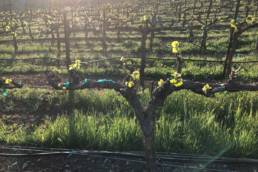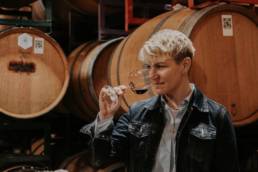FMN – January 2019 – Seven Years and Unusual Wines to Celebrate
Seven Years and Unusual Wines to Celebrate
As Bottle Talk begins its seventh year, I wanted to take this opportunity to reflect on our journey through the world of wine and spirits. We’ve covered numerous topics, appellations and styles of beverages all in the hopes of expanding your tasting profile and perhaps even learning a little along the way. My hopes as a ‘teacher’ of sorts was to create a curiosity for these subjects and build confidence to trust your palate and not rely solely on what those so-called experts tell you. With that, I ask you to buckle up and continue to ride along because this year promises the best of the old with some new flair and, of course, some great wines.
As the New Year approaches, I take this time of year to scope out the shelves, talk to importers and wholesalers to see what’s new and interesting. Although the depth and breadth of the answers received could fill many articles, I did the ‘field research’ for you and sorted out a few to begin your year in a unique and interesting way.
Those that know me personally or through articles, tastings, classes, etc. know that I have a love affair with sparkling wines. I am especially vulnerable to unusual appellations or unique grapes used in making these wines. So when I recently stumbled on a producer in Slovenia that creates sparkling from the Ribolla Gialla grape, the temptation was too much for me.
Slovenia has a long standing tradition of wine production that dates back to pre-Roman times. Our focus on the appellation of Goriška Brda (gore-eesh-ka bird-a) is located just across the northeastern Italian border contiguous with DOC Collio. Vineyard holdings here are similar to Burgundy in that many families own small parcels that they farm but instead of negociant wines, cooperatives dominate the market. The main cooperative, Klet Brda, combines the work and land of 400 families to make all styles of wines, including sparkling from the indigenous Ribolla Gialla.
Next we move over to the Txakoli (sha-kol-ee) wines of the mysterious Basque region. Located partly in northern Spain and partly in southern France, this culturally distinct region remains known for the obscure grapes Hondarrabi Zuri (white) and Hondarrabi Beltza (red). Although documented growing in the area for hundreds of years, the oldest Designation of Origen for these wines belongs to D.O. Getariako, gaining this status in 1989. This gives us some insight to the region’s desire to produce serious, yet traditional, wines while competing on the international market. These youthful, fruit-forward wines are enjoyed locally by holding a glass pitcher, called a porron, above your mouth and pouring the wine directly in your gob. Practice with water first as I know first-hand that there is a learning curve with using this vessel.
Just when you thought the obscurity ended, we are now traveling to Morocco, in northern Africa. Wine has been made here with varying degrees of success since the Phoenicians. Recent outside investment, especially by French producers, and favorable government leadership has led to an increase in quality and greater international exposure. The appellation system here also reflects French influence with 12 appellation d’origine garantie (AOG) regions.
As one would expect, most production is red with a small amount of especially pale rosé and some austere whites. Although there are some indigenous grape varieties, the wines made from international varieties gain more attention and investment dollars. Although these wines can be exceptionally interesting, complex and well-priced, only a small amount of their wine exports finds its way to our domestic market. So when you see one, take a chance on it.
I know you are thinking that you just got through Christmas and the New Year so maybe you need to ‘dry out’ a little. Well that type of quitting is no way to start the New Year. These wines are sure to please the avid buyer, curious consumer or just the casual wine drinker attempting to find something new while attempting to avoid the droves of plonk on the shelves. I hope you enjoy and wish you and your family a happy and prosperous New Year.
The Wines:
Peneca Rebula Sparkling 2012 Goriška Brda, Slovenia $20.99
One first notices the deep gold color which can be attributed to Ribolla Gialla (aka Rebula here) with some skin contact and perhaps some slight oxidation. The nose is fruit-forward with prevalent bruised apples and an obvious nutty note. The palate has bright acidity, a mouth prickly mousse, and mimics the nose with a cider apple aspect. The absence of an autolytic component and bright fruit is due to Charmat method as opposed to traditional method. Have with creamy cheeses (brie), cheese sauces, and salty meats (prosciutto).
Ameztoi Txakoli Stimatum 2017 D.O. Getariako, Spain $22.99
The wine is a vibrant pale ruby with some garnet hints. The nose has a candid fruit component (very similar to carbonic maceration in Beaujolais Nouveau wines) with raspberry, cranberry and strawberry. There is a baking spice similar to anise or clove. The palate has mouth-watering acidity, slight petillance (prickly feeling from lazy bubbles), a light body with distinct minerality and a lingering unsweetened jolly rancher like finish. This fun wine would be better served slightly chilled with porron in hand. Pair with fried snacks, cured meats and next year’s Thanksgiving meal.
Domaine de Sahari Rouge2013 Guerouane AOG, Morocco $12.99
This Cabernet Sauvignon / Merlot blend (60/40) has a dark ruby color with aromas of red and black fruits and a leathery, animal quality. The palate is slightly lighter in body than expected with well-integrated tannins, evident acidity, and flavors mimicking the nose. This wine begs for lamb tagine, lamb / beef stew or a meat-laden pizza. This wine drinks well above its price point and would be fun to serve blind at a party.




